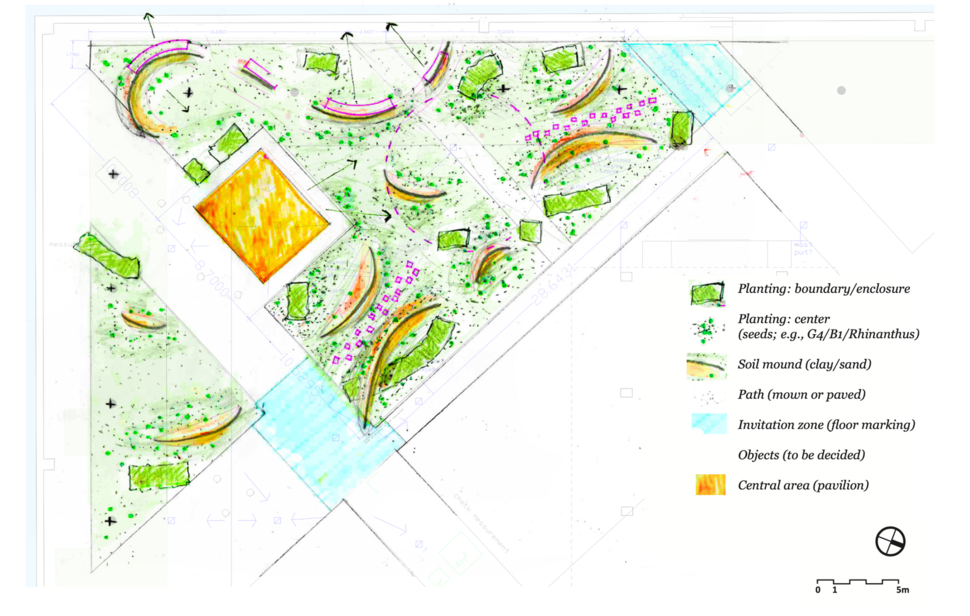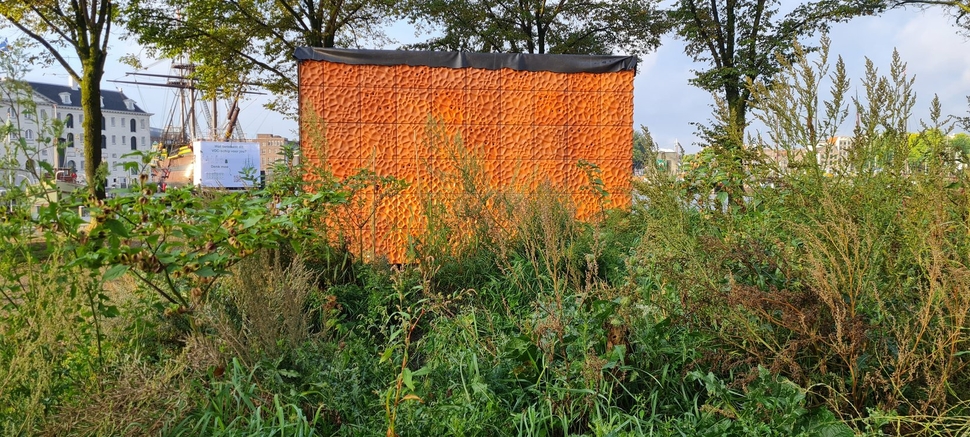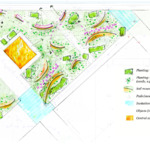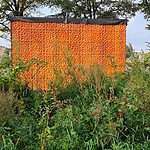When urban spaces are abandoned and left for nature to evolve, they often become havens for plants, birds, insects, and microbes. These spaces are like niches where spontaneous ecological processes inside the city occur. Nowadays urban environments are becoming increasingly congested and departing from nature. Leftover spaces offer opportunities to reinvite natural processes in the city and further let people appreciate the world of non-humans. In this context, deliberate design can enhance the biodiversity of the site while releasing the plural meaning of processes taking place in leftover green spaces that enabling citizens to better engage with these spaces. A real-life laboratory of wilderness is created on a once-neglected green parcel in Marineterrein Amsterdam. This field lab serves as a testing ground for design principles and the exploration of new uses and perceptions in this semi-wild environment, offering initial insights into embracing more spontaneous nature within the city of Amsterdam.
Informal green spaces
The city is planned with designated spaces that serve various functions, and this applies to urban green spaces as well. These green spaces are purposefully designed, for instance, as recreational parks or affiliated green spaces for environmental benefits. To guarantee the functionality of these green spaces, prescribed rules of regulation and maintenance are implemented, which keep the defined profile of these green spaces. For instance, gardeners would trim overgrown branches of trees, erasing weeds such as nettles and ragwort, and mow the lawn on a regular basis.
However, in the gaps that are left within the functioning urban system, we could discover alternative green spaces that that defy the typical characteristics of urban greens we are familiar with. These areas lack a predefined role in the urban system, allowing them to grow freely and evade the control of urban planning. Referred to as informal green spaces, they exist amidst formally designed and managed urban greens, offering unique opportunities for alternative processes to unfold. These informal green spaces are commonly found in abandoned old industrial sites, areas where buildings have been demolished, or simply overgrown patches next to roadsides. The defining feature of these informal green spaces is the absence of human manipulation, allowing spontaneous natural processes to take over and transform these areas over time. Gradually, these spaces can become as reservoirs of wild flora and fauna, accommodating species that find difficulties to thrive in everyday urban parks and gardens. The presence of informal green spaces provides a contrast to the carefully planned and managed urban green areas. They serve as a reminder of nature's resilience and its ability to reclaim spaces once shaped by human exploitational activities.
Informal green spaces do not only offer reservoirs of urban wilderness but also serve as catalysts for the emancipation of citizens and unlock new opportunities for outdoor activities and experiences. These spaces can be adventurous playgrounds for children, allowing them to unleash their creativity in the wild setting. They also provide neighborhoods casual meeting occasions, places for a leisurely stroll or for walking dogs. Some other informal green spaces, being more secluded, may provide a tranquil retreat where people can rest, disconnect, and restore their minds. These spaces open up new opportunities to reconsider urban environment, and more importantly, challenge our existing approaches working with urban nature.
However, not all aspects of wild nature in informal green spaces are favored by people. Since these spaces are unmanaged, they can sometimes be perceived as too untamed, unattractive, and potentially hazardous due to the presence of rats, insects or overgrown vegetation. People do not perceive these green spaces as valuable, or as something that can be engaged with, or an ecosystem that one wants to care for. This is where the design of informal green spaces plays a role.
A field lab on Marineterrein, Amsterdam
To test the abovementioned design roles, and investigate how people interact with the site, we initiated a field lab on two neglected green parcels, approximately 470 m2 in total, situated on Marineterrein in Amsterdam, in the vicinity of the AMS-building. These parcels are located in-between the water border on west-side and AMS building on the east side and are part of a cluster of green spaces previously designed by BOOM Landscape. Whilst the neighboring parcels were planted as flora gardens, these two parcels were kept as experimenting sites to test plant growth with brackish water conditions with minimal maintenance. The design of the site is conducted by following three design principles: 1. Understanding the existing site conditions; 2. Staging diverse natural processes; 3. Stimulating people’s engagement and experience.
An ongoing experimental space for research on urban greenery
Ongoing research activities are planned in the field lab, to experiment with preliminary research prototypes and methodologies. A privacy-friendly MM wave sensor that could monitor visitor movements and identify popular areas of engagement within the site. The methodology has been developed by the Responsible Sensing Lab at AMS, with the primary objective of creating new methods for privacy preserving crowd sensing systems.
Project leaders
- Prof. dr. Dipl.Ing. MA (AA) Sanda Lenzholzer, Wageningen University, department of Environmental Sciences, chair group Landscape Architecture | e-mail
- dr. ir. Agnès Patuano Wageningen University, department of Environmental Sciences, chair group Landscape Architecture | e-mail



